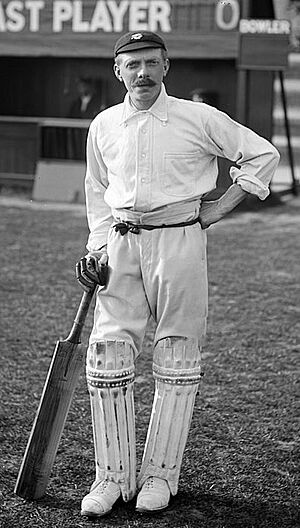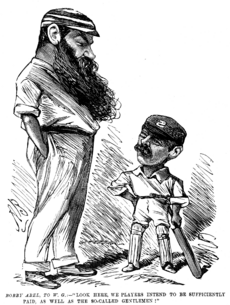Bobby Abel facts for kids

Abel in about 1900
|
||||||||||||||||||||||||||||||||||||||||
| Personal information | ||||||||||||||||||||||||||||||||||||||||
|---|---|---|---|---|---|---|---|---|---|---|---|---|---|---|---|---|---|---|---|---|---|---|---|---|---|---|---|---|---|---|---|---|---|---|---|---|---|---|---|---|
| Full name |
Robert Abel
|
|||||||||||||||||||||||||||||||||||||||
| Born | 30 November 1857 Rotherhithe, Surrey, England |
|||||||||||||||||||||||||||||||||||||||
| Died | 10 December 1936 (aged 79) Stockwell, London, England |
|||||||||||||||||||||||||||||||||||||||
| Nickname | The Guv'nor | |||||||||||||||||||||||||||||||||||||||
| Height | 5 ft 4 in (1.63 m) | |||||||||||||||||||||||||||||||||||||||
| Batting | Right-handed | |||||||||||||||||||||||||||||||||||||||
| Bowling | Right-arm off-break | |||||||||||||||||||||||||||||||||||||||
| Relations |
|
|||||||||||||||||||||||||||||||||||||||
| International information | ||||||||||||||||||||||||||||||||||||||||
| National side | ||||||||||||||||||||||||||||||||||||||||
| Test debut (cap 57) | 16 July 1888 v Australia | |||||||||||||||||||||||||||||||||||||||
| Last Test | 24 July 1902 v Australia | |||||||||||||||||||||||||||||||||||||||
| Domestic team information | ||||||||||||||||||||||||||||||||||||||||
| Years | Team | |||||||||||||||||||||||||||||||||||||||
| 1881–1904 | Surrey | |||||||||||||||||||||||||||||||||||||||
| Career statistics | ||||||||||||||||||||||||||||||||||||||||
|
||||||||||||||||||||||||||||||||||||||||
|
Source: CricketArchive, 5 October 2009
|
||||||||||||||||||||||||||||||||||||||||
Robert Abel (born November 30, 1857 – died December 10, 1936) was a famous English cricket player. People called him "The Guv'nor". He was an opening batsman for Surrey and the England team.
Bobby Abel was one of the best run-scorers in the early days of the County Championship. He was the first England player to "carry his bat" in a Test match. This means he started batting and stayed in the game until the very end of his team's turn. He was also the first player to score over 2000 runs in a season for many years in a row (from 1895 to 1902).
In 1899, playing for Surrey, Abel scored an amazing 357 runs without being out. This is still a record for Surrey. It was also the highest score ever made at The Oval cricket ground for a long time. Abel played in more first-class matches in one season than anyone else – 41 games in 1902.
Abel was not very tall, about 5 feet 4 inches. He had some trouble with his eyesight later in his career. But he was a very determined player. He used unusual batting strokes, like hitting the ball around his legs. This helped him succeed even on difficult cricket pitches. Fans really liked watching him play.
Contents
Bobby Abel's Cricket Journey

Bobby Abel started playing for Surrey in 1881. He became a strong player by 1883. In 1886, he scored over 1000 runs for the first time. By 1888, he had scored 1323 runs, including nine scores over fifty.
Playing for England
In 1888, Abel played his first Test matches for England. He scored 70 runs in a game at The Oval, helping England win. In 1889, he scored 120 runs in a Test match in South Africa. England then bowled out South Africa for very low scores, winning easily.
For the next 14 years, Abel was one of England's top run-scorers. He had a small injury in 1893, but he always played well. He even played well in Australia during the winter of 1891.
Setting New Records
In 1895, Abel became an amazing run-scorer. He was only the fourth player ever to reach 2000 runs in a season. He also scored his first double hundred (over 200 runs) against Essex. Even though his eyesight problems meant he wasn't always chosen for Test matches after 1896, he kept scoring lots of runs.
He was the only player to score 2000 runs in 1897 and 1898. In 1899, he scored 2685 runs. In 1900, he scored 2592 runs. Then, in 1901, he scored 3309 runs, which was the highest total at that time! He scored over 2000 runs again in 1902.
Final Years in Cricket
In 1902, Abel played very well on difficult pitches. This led to him being called back to play for England in two Test matches. However, he didn't score many runs in those games. In 1903, an injury caused Surrey to drop him from the team. He was fit again in 1904, but he didn't score as many runs. He decided to retire from cricket that year. Another great player, Jack Hobbs, took his place.
Later Life and Legacy
Later in his life, Bobby Abel became completely blind. He passed away at age 79 in London. He is buried in Nunhead Cemetery with his wife, Sarah. They had 11 children. Two of his sons, Tom and William, also played cricket for Surrey.
In 2005, a special blue plaque was put up in Southwark Park to remember Bobby Abel.

